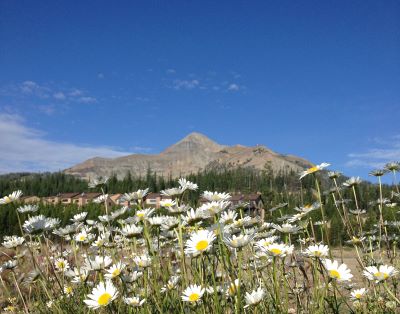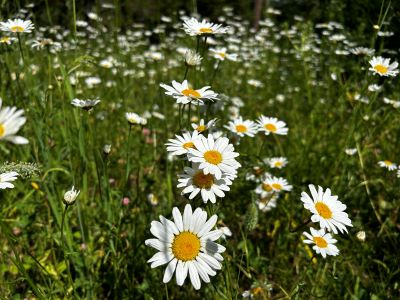Oxeye Daisy: I love it, I love it not
Introduction
Oxeye daisy (Leucanthemum vulgare) is a perennial forb that is

Photo; Jen Mohler, Grow Wild, growwildmt.org
on several state noxious weed lists, including Montana. Its beauty, showiness, and propensity to grow in mountain communities popular with recreationalists presents interesting noxious weed education opportunities. Oxeye daisy was introduced to North America from Europe, both intentionally as an ornamental and accidentally as a seed contaminant. Its flowers have been admired by gardeners and poets, and it has been used for culinary purposes and home remedies. Fun fact: In the early 19th century, fresh oxeye daisy flowers were used to drive away fleas. Fun activity: Use your favorite search engine to explore oxeye daisy poems and quotes.
Identification
Arguably one of the easiest noxious weeds to identify, oxeye daisy has

Photo; Noelle Orloff, MSU
white petals surrounding a yellow center. Flower heads, which are 1 to 2 inches across, are borne individually on top of long, slender stems that can be 1 to 3 feet tall. Leaves are smooth, dark green and glossy and decrease in size upward on the stem. Basal and lower leaves are lobed and have pedicels (stalks); upper leaves attach directly to the stem (no pedicels). Oxeye daisy has shallow rhizomes and adventitious roots, which are roots that arise from any part of a plant other than the primary root system.
The most challenging aspect of identifying oxeye daisy is that two other daisy-like species look similar: Shasta daisy (Leucanthemum × superbum) and scentless chamomile (Tripleurospermum inodorum). Shasta daisy is a well-behaved ornamental that originated from a cross of several daisy species including oxeye. It is typically taller and has larger flowers (>2 inches) than oxeye daisy. Basal leaves of Shasta daisy are not as lobed as those of oxeye daisy, and Shasta daisy has fibrous roots instead of creeping. Scentless chamomile is a noxious weed in some Montana counties. It has smaller flowers (1 inch) and highly divided, fern-like leaves.
Biology and Ecology
Oxeye daisy reproduces primarily by seed, but its rhizomes also contribute to spread. Seed production can range from 1,300 to 26,000 seeds per plant. Most seeds live at least 6 years, but some have been found to live up to nearly 40 years. Oxeye daisy seeds can still be found in wildflower seed mixes. While the full extent of ecological and economic impacts of oxeye daisy are not documented, the greatest impact is decreased forage production in heavily infested pastures and meadows.
Management
Hand-pulling/digging can be used to control small populations of oxeye daisy. The root system is shallow, and plants can be dug up and removed. Mowing may reduce seed production if plants are mowed as soon as flower buds appear. Herbicides containing the active ingredient aminopyralid (e.g., Milestone) or metsulfuron (e.g., Escort) are effective on oxeye daisy in range and pasture settings. Herbicides should be applied at the rosette to early flowering growth stage; for specifics on timing of application, the product label should be followed. A root-feeding moth is currently being investigated as a biological control agent. Oxeye daisy is not highly competitive, and reinvasion following control efforts can be slowed by establishing and maintaining a healthy, desirable plant community. See the MSU Extension publication “Oxeye Daisy: Identification, Biology, and Integrated Management” for more information on management.
Further Information
For more information about this month's weed post, contact Associate Extension Specialist Noelle Orloff. Past posts are available in the Monthly Weed Post Directory.
This weed post is also available as a printable PDF (233 KB).
